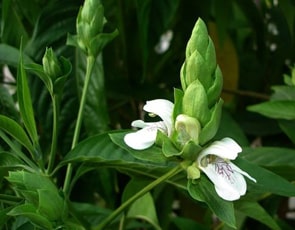
Common names
The Adhatoda vasica is commonly known as Malabur nut in English, Vasaka in Sanskrit and Adosa in Hindi.
Occurrence of Adhatoda vasica
This plant is found in Srilanka, Nepal, Pakistan, Indonesia, China and Malaysia and Panama as well. In India, this shrub grows on the plains and the lower Himalayas up to a height of 100 m. This plant grows well in dry soils as well as in low moisture areas.
Description of Adhatoda vasica plant
This plant has lance-shaped leaves which are 10 to 15 cm tall. They are smooth edged, arranged oppositely and borne on short petioles. They are dull brownish green in color, when dry. They are bitter in taste. When a leaf of this plant is cleared and if examined, then the oval stomata can be seen. Stomata are surrounded by the two crescent shaped cells that are at right angles to the ostiole. The epidermis contains simple celled warty hairs as well as small glandular hairs. Beneath the epidermis, Cystoliths occur. The trunk of this plant has many long and ascending branches and are arranged oppositely. Flowers are white in color and the bark of this plant is yellow in color. Inflorescence shows the presence of large, dense and axillary spikes. The fruits of this plant are with club shaped capsule and are pubescent.
Parts Used
Root, flowers, bark and leaves of this plant are extensively used.
What is Ayurveda?
Ayurveda is an ancient healthcare system that helps to maintain a healthy body by balancing the three doshas of the body. There are three doshas namely, Vata, Pitta and Kapha dosha. These tridoshas are considered as the energies or the forces of the body. According to Ayurveda, any imbalance in any of the doshas result in one or the other health condition.
Ayurvedic Energetics of Adhatoda vasica
- Rasa (Taste) – Bitter, Astringent
- Veerya (Potency) – Sheeta (cold)
- Vipaka (Post digestion effect) – Pungent.
- Guna (Characteristics) – light, rough
- Actions on Doshas – Vata aggravating, Anti-Kapha, Anti-Pitta.
Chemical constituents present in Adhatoda vasica
This plant contains alkaloids, tannins, phenolics, flavonoids, tannins, etc. in it. The leaves of this plant are the rich sources of carotenes and vitamin C.
- Alkaloids: Vasicine is the major alkaloid present in this plant. The leaves of this plant contain alkaloids like vasicinone, vasicinol, adhatonine, adhatodine, etc. while the roots of this plant contain vasicinol, vasicinolone, vasicol, etc.
- This plant contains triterpenes and phytosterol such as a-amyrin, epitaraxerol and oaucosterol.
- Flavonoids like apigenin, kaempferol, astragalin, quercetin, isovitexin, vitexin, etc. are found in the flowers and leaves of this plant.
- Essential oils: The flower of this plant has volatile oil which contains ‘ketone’ in it along with other 36 components.
- This plant also contains hydrocarbons and fatty acids. The oil extracted from the leaves of this plant contains about 50 compounds in it. Out of these, the major component is ‘decane’. The other components that are present in this plant, include lilolenic, arachidonic, palmitic and oleic acids.
To buy Vasaka Powder, please visit store.planetayurveda.com/products/vasa-powder
